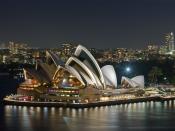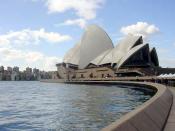1.1: Background
1.1.1: Introduction
The Sydney Opera House represents a great architectural triumph being ranked amongst the most popular buildings in the world alongside the Arc de Triomphe in Paris and the Empire State Building in New York. However it can also be described as an economic and planning disaster setting some kind of world record in time and cost escalation.
The existence of this unique cultural monument between Australia's equivalent to Plymouth Rock and the Sydney Harbour Bridge stemmed from the imagination and forcefulness of two individuals who saw the location as a logical place to site what was to become a popular symbol.
One of these was Eugene Goosens, director of the New South Wales Conservatorium of Music and resident conductor of the Sydney Symphony Orchestra, who campaigned from 1947 for an opera house and concert hall worthy of a great metropolitan city. The other was John Joseph Cahill, in the 1950s the Labor Prime Minister of New South Wales State who saw it as a political opportunity for a great imaginative venture.
1.1.2 Inception of the project
In November 1954, a committee was set up to consider the building of an opera house, and by 1955 it had announced its terms thus:
- A large hall was required with a capacity 3,000 to 3,500 people to accommodate grand opera, symphony concerts, choral works, ballet, and large meetings.
- A small hall was also required with a capacity 1,200 for drama, intimate opera, chamber music, smaller concerts, and recitals.
1.1.3 The scheme design
Because of its nature, as a prestige project, the design was opened to international competition and a jury of four - including Eero Saarinen of the USA was appointed to judge entries. Of the 233 submissions, the jury selected the scheme designed by an...


